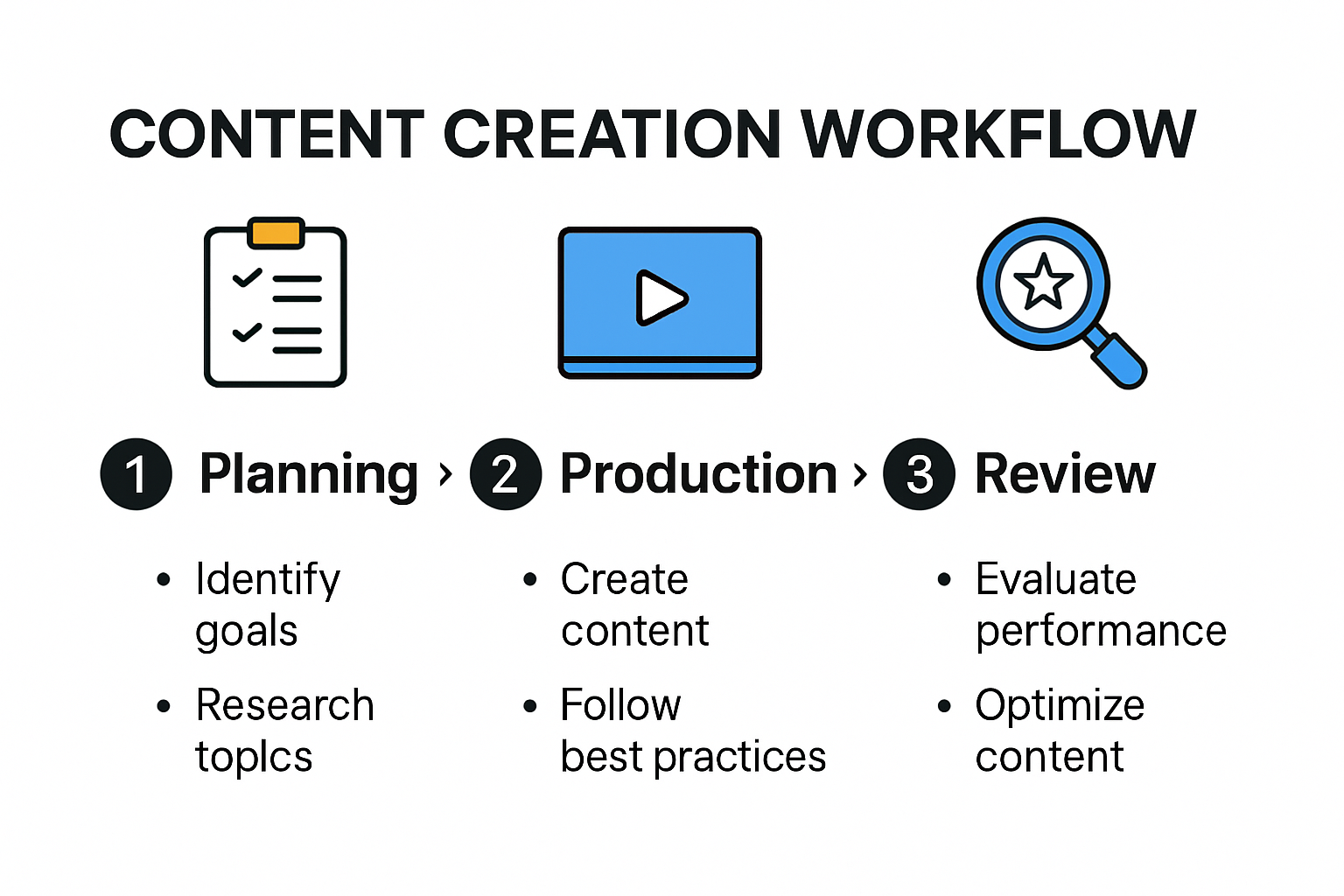Content Creation Workflow for 2025: A Complete Guide


Building great content is only half the battle for teams in 2025. Here is a wild truth: organizations with well-defined content plans are 60 percent more likely to succeed than those winging it. Yet, even the perfect plan can fall apart if your workflow is stuck in the past. Find out how small shifts and the right tools are giving content creators a massive edge this year.
Table of Contents
- Key Stages Of A Content Creation Workflow
- Best Tools For Streamlining The Process
- Common Challenges And Smart Solutions
- Optimizing Your Workflow For SEO Success
Quick Summary
| Takeaway | Explanation |
|---|---|
| Strategic Content Planning is Crucial | Understanding audience needs and aligning content with business objectives is essential for creating effective content. Research suggests that organizations with defined content plans are 60% more likely to succeed. |
| Efficient Use of Collaboration Tools Accelerates Production | Utilizing integrated collaboration platforms can reduce communication overhead and speed up content production cycles by 35%. |
| AI Tools Enhance Content Quality and Efficiency | Implementing AI-powered tools can significantly reduce the time required for content development while maintaining high-quality standards and consistency. |
| Addressing Resource Allocation is Key | Managing limited resources effectively and utilizing agile methodologies can increase productivity by 30%, highlighting the need for strategic workflow optimization. |
| Continuous SEO Optimization is Essential | Integrating SEO strategies, including keyword research and technical SEO, is crucial for transforming content into valuable digital assets that drive organic traffic. |

Key Stages of a Content Creation Workflow
Creating effective content requires a structured approach that transforms raw ideas into compelling digital assets. A robust content creation workflow enables teams to produce high-quality content consistently while maintaining efficiency and strategic alignment.
Strategic Content Planning
Successful content creation begins with meticulous planning. According to Content Marketing Institute, strategic content planning involves understanding your audience's needs and aligning content with specific business objectives. This stage requires comprehensive research to identify target audience preferences, pain points, and information consumption patterns.
Effective planning encompasses several critical elements:
- Audience Insights: Developing detailed personas that capture demographic and psychographic characteristics
- Keyword Research: Identifying search terms and topics with high engagement potential
- Content Mapping: Aligning content types with different stages of the customer journey
Professional content teams utilize data-driven approaches to develop content strategies. SEMrush research suggests that organizations with well-defined content plans are 60% more likely to produce successful marketing materials.
Content Production and Optimization
Once planning is complete, the content production phase begins. This stage involves transforming strategic insights into tangible content assets. The process typically includes multiple interconnected steps:
Content creators focus on developing engaging, valuable content that addresses specific audience needs. This requires a combination of creativity, technical writing skills, and strategic thinking. Writers must balance SEO requirements with authentic, reader-centric communication.
Key production considerations include:
- Quality Standards: Maintaining consistent tone, style, and brand voice
- SEO Integration: Incorporating relevant keywords naturally
- Multimedia Enhancement: Adding visual elements that support written content

Review and Refinement Process
The final stage of the content creation workflow involves comprehensive review and optimization. According to Content Marketing Institute, successful content undergoes multiple rounds of editing and refinement.
Review processes typically include:
- Grammar and technical accuracy checks
- Alignment with brand guidelines
- SEO optimization verification
- Potential performance impact assessment
Professional content teams often implement collaborative review systems that involve multiple stakeholders. This approach ensures content meets both creative and strategic objectives.
By implementing a structured content creation workflow, organizations can transform content from a random activity into a strategic business function. The key lies in developing a repeatable process that balances creativity with systematic execution.
Effective workflows are not static but evolve with changing audience preferences, technological capabilities, and market dynamics. Continuous refinement and adaptation remain crucial for maintaining content relevance and impact.
To clarify the phases and main actions of the content creation workflow, the following table summarizes the key stages and their critical tasks.
| Workflow Stage | Key Activities |
|---|---|
| Strategic Content Planning | Audience research, keyword research, content mapping |
| Content Production & Optimization | Drafting, SEO integration, multimedia addition, quality control |
| Review & Refinement | Editing, brand and SEO checks, stakeholder review, performance assessment |
Best Tools for Streamlining the Process
Content creation workflows demand sophisticated tools that enhance productivity, collaboration, and output quality. Modern digital platforms offer comprehensive solutions designed to transform how teams conceptualize, develop, and optimize content across various channels.
Content Management and Collaboration Platforms
Effective content creation requires robust platforms that facilitate seamless collaboration and project management. Gartner research indicates that organizations using integrated collaboration tools experience 35% faster content production cycles.
Top collaboration platforms provide critical features:
- Real-time Editing: Simultaneous document collaboration
- Version Control: Tracking changes and maintaining content history
- Assignment Tracking: Clear workflow management and accountability
Professional teams increasingly rely on cloud-based solutions that enable distributed workforce collaboration. Microsoft research demonstrates that integrated collaboration tools can reduce communication overhead by up to 25%.
AI-Powered Content Generation Tools
Artificial Intelligence is revolutionizing content creation workflows. According to GAIDE framework research, generative AI tools can significantly reduce content development time while maintaining high-quality standards.
Advanced AI tools offer capabilities such as:
- Automated Content Drafting: Generating initial content drafts
- SEO Optimization: Suggesting keyword integrations
- Tone and Style Consistency: Maintaining brand voice across multiple content pieces
The CollabCoder workflow study highlights how Large Language Models can provide intelligent suggestions and streamline collaborative content creation processes.
Analytics and Performance Tracking Tools
Content optimization requires sophisticated analytics platforms that provide actionable insights. Modern tools go beyond basic metrics, offering comprehensive performance analysis and predictive recommendations.
Key analytics features include:
- Engagement Tracking: Measuring content interaction rates
- Audience Segmentation: Understanding content performance across different demographic groups
- Competitive Benchmarking: Comparing content performance against industry standards
Successful content creation workflows integrate multiple tools that address different stages of content development. The most effective approaches combine collaborative platforms, AI-powered generation tools, and robust analytics to create a comprehensive ecosystem.
As technology continues to evolve, content creation tools will become increasingly intelligent and adaptive. Teams that invest in versatile, integrated solutions will maintain a competitive edge in the rapidly changing digital content landscape.
The following table provides a comparison of key tool categories and their most important features to help teams choose the right solutions for each workflow stage.
| Tool Category | Main Features |
|---|---|
| Collaboration Platforms | Real-time editing, version control, assignment tracking |
| AI Content Generation Tools | Automated drafting, SEO suggestions, tone consistency |
| Analytics & Performance Tracking Tools | Engagement tracking, audience segmentation, benchmarking |
Common Challenges and Smart Solutions
Content creation workflows encounter numerous obstacles that can impede productivity and quality. Understanding these challenges and implementing strategic solutions is crucial for maintaining an effective content production process.
Resource Allocation and Efficiency Bottlenecks
One of the most significant challenges in content creation is managing limited resources and preventing workflow bottlenecks. Research from McKinsey indicates that organizations lose up to 20% of productive time due to inefficient workflow management.
Common resource challenges include:
- Time Management: Balancing content creation with other business priorities
- Skill Gaps: Finding team members with diverse content creation capabilities
- Budget Constraints: Managing content production costs effectively
Smart solutions involve implementing agile workflow methodologies and leveraging technology to automate repetitive tasks. Gartner research suggests that organizations can increase productivity by 30% through strategic workflow optimization.
Content Quality and Consistency Challenges
Maintaining consistent content quality across multiple channels and team members presents a significant challenge. According to ResearchGate studies, integrating AI into content management systems can help address these consistency issues.
Key quality challenges include:
- Brand Voice Alignment: Ensuring consistent tone and messaging
- Technical Accuracy: Maintaining factual precision
- SEO Optimization: Creating content that meets search engine requirements
AI-powered tools offer innovative solutions for content standardization. Forbes research highlights the potential of auto-tagging tools in efficiently managing and reusing high-performing content assets.
Collaboration and Communication Barriers
Effective content creation requires seamless collaboration across different teams and departments. Communication breakdowns can significantly impact content quality and production speed.
Primary collaboration challenges include:
- Remote Work Complexities: Managing distributed teams
- Interdepartmental Communication: Aligning content with broader business objectives
- Feedback Integration: Implementing constructive review processes
Advanced collaboration platforms and project management tools can help mitigate these challenges. Implementing clear communication protocols and using integrated workflow management systems enables teams to overcome traditional collaboration barriers.
Addressing content creation challenges requires a multifaceted approach that combines technological solutions, strategic planning, and continuous team development. Organizations must remain adaptable and willing to invest in tools and training that enhance workflow efficiency.
The most successful content teams view challenges as opportunities for innovation. By developing robust problem-solving strategies and embracing technological advancements, businesses can transform potential obstacles into competitive advantages in the dynamic digital content landscape.
Optimizing Your Workflow for SEO Success
Search engine optimization represents a critical component of modern content creation workflows. Strategic SEO integration transforms content from mere text into powerful digital assets that drive organic traffic and enhance online visibility.
Strategic Keyword Integration
Effective SEO begins with intelligent keyword research and strategic implementation. Research from Ahrefs indicates that successful content strategies prioritize long-tail keywords with specific user intent, enabling more targeted content development.
Successful keyword strategies involve:
- Intent Mapping: Understanding user search motivations
- Competitive Analysis: Identifying gap opportunities in existing content
- Semantic Keyword Clustering: Developing comprehensive content themes
Advanced practitioners utilize machine learning tools to predict keyword performance and potential audience engagement. Google Search Central recommends focusing on user-centric content that naturally incorporates relevant search terms.
Content Performance Optimization
Generative Engine Optimization (GEO) represents an emerging approach to content visibility. According to research from Cornell University, strategic optimization can boost content visibility by up to 40% in AI-generated search responses.
Key optimization techniques include:
- Structured Data Implementation: Enhancing content readability for search algorithms
- Content Depth: Creating comprehensive, authoritative pieces
- Metadata Refinement: Crafting compelling titles and descriptions
Interestingly, neural network research suggests that predictive systems can now forecast content attractiveness, providing actionable insights for marketing professionals.
Technical SEO Workflow Integration
Technical SEO elements require systematic integration throughout the content creation process. Mozilla Developer Network emphasizes the importance of holistic optimization strategies that extend beyond simple keyword placement.
Critical technical considerations include:
- Page Speed Optimization: Ensuring rapid content loading
- Mobile Responsiveness: Creating adaptive content experiences
- Internal Linking Strategies: Developing comprehensive content ecosystems
Surprisingly, academic research reveals that non-optimized content from trusted sources can sometimes outrank technically optimized pages, underscoring the continued importance of genuine expertise and quality.
Successful SEO workflows demand continuous learning and adaptation. Search algorithms evolve rapidly, requiring content creators to remain agile and informed about emerging optimization techniques.
The most effective approach combines technical precision with genuine user value. By developing content that genuinely serves audience needs while meeting technical optimization requirements, teams can create powerful digital assets that perform exceptionally across search platforms.
Frequently Asked Questions
What are the key stages of a content creation workflow?
The key stages of a content creation workflow include Strategic Content Planning, Content Production and Optimization, and Review and Refinement Process. Each stage focuses on different aspects of transforming ideas into high-quality content that aligns with strategic objectives.
How can AI tools improve the content creation process?
AI tools enhance the content creation process by automating tasks like content drafting, suggesting SEO optimizations, and maintaining tone consistency across various pieces. This improves efficiency while ensuring high-quality output.
What are some common challenges in content creation workflows?
Common challenges include resource allocation issues, maintaining content quality and consistency, and collaboration barriers among team members. Addressing these challenges requires strategic planning and the use of effective project management tools.
How does SEO integration impact the content creation workflow?
Integrating SEO into the content creation workflow enhances the visibility and effectiveness of content. This involves strategic keyword integration, performance optimization, and ensuring technical SEO is considered throughout the process.
Transform Your 2025 Content Workflow into Real SEO Success
Are you tired of seeing your careful content plans get lost in a maze of inefficiency and inconsistent results? The article highlighted how essential it is to combine sharp content strategy with smart automation, especially if you want to tackle challenges like scattered resource allocation, collaboration bottlenecks, and lagging SEO performance. Many teams are still missing out on growth because they lack a unified solution that connects business goals, audience insights, and continuous optimization.

Stop letting outdated workflows limit your brand's online potential. Discover how BabyLoveGrowth.ai can take your content creation process further. Our platform analyzes your unique business landscape, crafts a custom 30-day content plan, and delivers SEO-optimized articles automatically. Elevate your quality, speed up production, and start climbing those search rankings instantly. If you are serious about getting ahead in 2025, now is the best time to see how our automated SEO content generation works. Take action today and let your content finally work as hard as you do.
Recommended
Smart SEO,
Faster Growth!
Most Read Articles

Generative Engine Optimization (GEO)
Learn how Generative Engine Optimization (GEO) helps your content rank in AI search engines like ChatGPT and Google AI. This comprehensive guide explains the differences between SEO and GEO, why it matters for your business, and practical steps to implement GEO strategies for better visibility in AI-generated responses.

Track LLM Traffic in Google Analytics 4 (GA4)
Learn how to track and analyze traffic from AI sources like ChatGPT, Claude, Perplexity, and Google Gemini in Google Analytics 4. This step-by-step guide shows you how to set up custom filters to monitor AI-driven traffic and make data-driven decisions for your content strategy.

How to Humanize AI Text with Instructions
Learn practical techniques to make AI-generated content sound more natural and human. This guide covers active voice, direct addressing, concise writing, and other proven strategies to transform robotic text into engaging content.

Open AI Revenue and Statistics (2024)
Comprehensive analysis of OpenAI financial performance, user engagement, and market position in 2023. Discover key statistics including $20B valuation, $1B projected revenue, and 100M+ monthly active users.